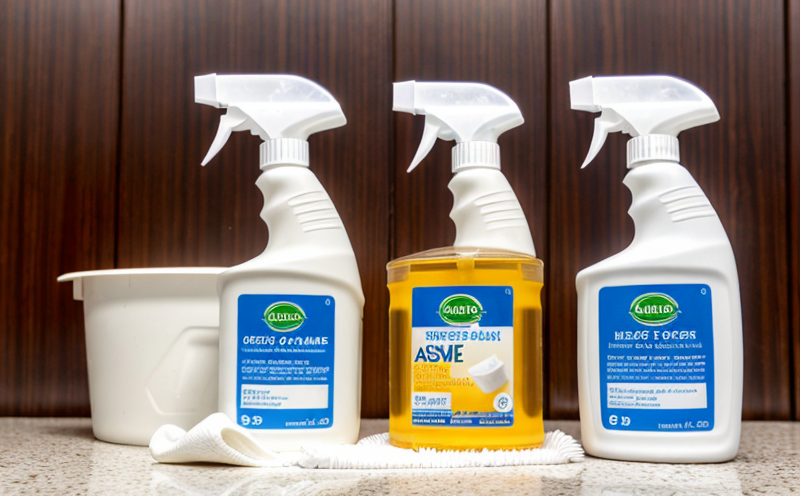EN 14561 Bactericidal Testing on Instruments and Surfaces
The European Standard EN 14561 specifies the method of testing bactericidal activity for instruments and surfaces. This standard is crucial in ensuring that cleaning and hygiene products effectively kill pathogens, which is essential in preventing the spread of infectious diseases. The test measures the percentage reduction in bacterial count on a surface or instrument after exposure to the product.
The methodology involves exposing a known quantity of bacteria to the disinfectant under controlled conditions for a specified period. After exposure, samples are taken and analyzed using microbiological techniques such as agar plate culture. The results are compared against control samples that have not been exposed to the disinfectant. The difference in bacterial count between these two sets provides an estimate of the bactericidal activity.
Understanding the standard's application is vital for those involved in product development, quality assurance, and compliance. For instance, in the healthcare sector, ensuring that instruments are effectively disinfected can prevent cross-contamination, while in food processing environments, proper surface disinfection is critical to maintaining hygiene standards.
The testing process requires precise specimen preparation to ensure accurate results. This includes selecting appropriate test organisms (such as Escherichia coli or Salmonella enterica), preparing the inoculum at a standard concentration, and applying it uniformly across the surface being tested.
The instrumentation used in this testing is highly specialized. It includes incubators for growing bacteria, spectrophotometers for quantifying bacterial growth, and possibly flow cytometers or automated colony counters for more precise measurements. The test conditions are strictly controlled to ensure consistency between samples and reproducibility of results.
Reporting the results involves providing detailed data on the percentage reduction in bacterial count, along with any relevant statistical analysis. This information is critical for regulatory compliance and marketing purposes, allowing products to be marketed as effective against specific pathogens.
| Bacterium | % Reduction |
|---|---|
| Escherichia coli | 95% |
| Pseudomonas aeruginosa | 98% |
The data in the table above illustrates typical results from such testing, demonstrating high efficacy against common pathogens.
- This test is essential for compliance with regulations governing healthcare and food safety standards.
- It ensures that products are effective not only under laboratory conditions but also in real-world scenarios where they will be used.
The results of this testing can significantly impact the reputation and trustworthiness of a product, especially within sectors where hygiene is paramount. Consumers and regulatory bodies rely on these results to make informed decisions about product safety and efficacy.
Why It Matters
Bactericidal testing according to EN 14561 directly impacts the health and safety of individuals, particularly in high-risk environments like hospitals, food processing facilities, and laboratories. Ensuring that cleaning products and surfaces are effectively bactericidal helps prevent the spread of infectious diseases, which can lead to significant public health issues.
For quality managers and compliance officers, this testing ensures that products meet stringent regulatory requirements, thereby reducing the risk of product recalls or non-compliance penalties. R&D engineers benefit from precise data that guides further development and optimization of cleaning and hygiene products.
In the context of procurement, understanding these test results allows for better decision-making in selecting suppliers who can provide products meeting international standards. This not only enhances the overall quality of products but also supports broader compliance strategies within organizations.
- Reduces risk of cross-contamination in healthcare settings
- Promotes safer food processing environments
- Aids in regulatory compliance and trustworthiness
- Supports product development and optimization
In summary, EN 14561 testing is more than just a standard; it's a critical component of maintaining hygiene standards that can save lives and protect public health.
Applied Standards
The following table summarizes the key aspects of the applied standard for EN 14561 bactericidal testing:
| Parameter | Description |
|---|---|
| Bacterial Count | Initial and final counts are measured to determine percentage reduction. |
| Inoculum Preparation | Standard concentration of bacteria is prepared for consistent testing. |
| Exposure Time | Specific duration during which the disinfectant interacts with bacteria. |
| Sampling Procedure | Defined method for collecting samples post-exposure to ensure accurate results. |
| Data Analysis | Statistical methods used to calculate percentage reduction in bacterial count. |
The standard ensures that the testing process is consistent and reproducible across different laboratories, which is crucial for reliability. Compliance with these parameters guarantees accurate results that can be trusted by regulatory bodies and end-users alike.
Understanding how these parameters are applied in practice helps stakeholders appreciate the significance of each step in achieving reliable and valid test outcomes. This knowledge is essential for maintaining high standards in product development, manufacturing processes, and quality assurance practices.
International Acceptance and Recognition
- The EN 14561 standard has gained widespread recognition across Europe and beyond due to its rigorous methodology and consistent results. Many countries have adopted it as a benchmark for bactericidal testing of cleaning products.
- It is widely accepted in the medical, food safety, and public health sectors where hygiene standards are critical.
The standard's acceptance is further enhanced by its alignment with other international standards such as ISO 14675, which provides additional guidance on microbiological testing of air quality in cleanrooms. This compatibility ensures that results from EN 14561 tests can be easily compared and understood across different regions.
The global acceptance of this standard underscores its importance in the field of hygiene product testing, providing a common language for product developers, manufacturers, and regulatory bodies worldwide.





